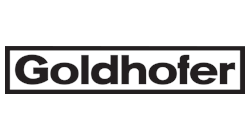Goldhofer’s fairytale began in 1705 when the Goldhofer family of Amendingen, Germany gave birth to a local forge. Little did they know that the small, spark-spewing shanty would transform into a global operation servicing 70 worldwide countries with nearly 500 employees.
In 1946, the eighth generation in a long line of excellent craftsmanship, Alois Goldhofer, opened a German vehicle plant as his foot in the economic production door. Starting off with the steel construction of agricultural trailers with pneumatic tires, Goldhofer—in cooperation with tire producer Metzeler—created the first lowloader with rear-end loading.
Originally servicing the agricultural market, Alois was able to expound upon his early success and—with the creation of the lowloader—add a few more names to the rolodex by branching into the transportation and construction markets.
1950’s: Decade of the Lowloaders
Beginning in 1952, Goldhofer’s lowloading innovations transformed the marketplace and in 1956 the company developed lowbed trailers with a detachable rear axle. Alois had developed a special axle construction that could easily be separated and detached from the vehicle after lowering the loading platform. As payloads increased exponentially, the market demanded a new alternative and Goldhofer’s creation made the process of loading and unloading easier.
The 1950’s sales boom provided the financial capacity and necessity to transform Goldhofer from a manual operation to an industrial production company. In 1959 Goldhofer AG’s new headquarters was erected in Memmingen—where it remains the base of operations. The new plant was built to develop and produce vehicles for transportation and construction industries that were constantly demanding bigger and heavier machinery.
1963-1980: Things get Heavy
As the customer demanded bigger and better operational equipment, the term ‘heavy-duty’ accompanied a slew of products added to the Goldhofer catalog. In 1963, Goldhofer started the development of the new heavy-duty combination trailers with mechanical axle suspension and mechanical steering.
The hydraulic system was not that advanced at the time, but Alois had developed a modular system as an alternative. The system made it possible for the clients to create a vehicle combination to load up to eight axle lines made up of two-axle modules each, thus being able to transport different loads with just one vehicle system. The different loading platforms that were already telescopic or adjustable in width at the time, completed this system.
These dinosaurs slowly evolved into today’s modular system of vehicles with hydraulic axle load compensation.
In 1972 Alois Goldhofer presented his latest invention, the heavy duty modular combination system with swing axles, hydraulic axle load compensation and hydromechanical all-wheel steering. It was a mouthful, but the vehicle combination was adjustable in width from 2,750 to 4,700 mm with hydraulic axle load compensation for transporting voluminous containers or vessels.
The new vehicle types with five, two and five axle lines could be combined with up to twelve axle lines and could handle a total payload of 286,600 pounds.
In the late 1970’s, Alois and company reached a milestone. As of 1979, more than 10,000 Goldhofer vehicles were in operation in 56 different countries all around the world.
1981: End of an Era
On January 16, 1981 Goldhofer’s founding father passed away while vacationing in the mountains. Alois Goldhofer was 58 years old.
New Market: The GSE Industry
Goldhofer began the development of the first towbarless aircraft tractor in 1987. The first AST-prototype—tried and tested by Swissair—was originally designed for 180-ton aircraft. The prototype weighs 12,000 kg and is equipped with a KHD V10-cylinder-diesel type F10L413 of 280 hp and is still in use at Zurich airport after more than 28,000 operating hours and nearly 100,000 aircraft movements.
Following the positive results after testing the first towbarless aircraft tractor, Swissair ordered the construction of a corresponding tractor type AST-1 A840 with two six-cylinder diesel engines for towing wide-body aircraft up to Boeing B747.
Goldhofer had not only found itself entering the ground support arena, but in 1988 the company’s engineers observed an improvised recovery of a Boeing B747 by a local haulage firm in India. The lightbulbs above their heads shone bright while watching the salvage struggle. The ensuing product was an aircraft recovery system for the recovery and transport of damaged wide-body aircraft.
Goldhofer had discovered a knack for the aircraft tractor and after delivering more than 30 units, the company started the development of the second towbarless generation with digital CAN-Bus technology.
The New Millennium
In 2000 Goldhofer delivered both its 100th aircraft tractor and its 25,000th lowloader. While the experience is lopsided, the new millennium also ushered in business with Air China. As of 2001, Goldhofer had more than 160 tractors on duty for more than 700,000 working hours and had performed over 2,000,000 aircraft movements.
With the creation of the airbus A380 has come the three-axle AST-1 X the biggest towbarless aircraft tractor in the world. The AST-1 X—developed in 2004—is equipped with a maximum of two V8 diesel engines with 440 kW/600 hp each. The AST-1X reaches speeds up to 30 km/h while towing a 300,000 kg aircraft and is slender enough (4,500 x 11,250 mm) to operate in a confined space. Even before the maiden flight of the airbus A380, a pair of AST-1 Xs were presented to Airbus in Hamburg, Goldhofer’s first customer, in March 2005.
Goldhofer’s international grasp around the globe has provided products for the various requirements of any transportation. That 300-year-old forge has evolved into a multi-industry giant for more than 28,000 general road, heavy duty and special transport vehicles in operation in over 70 countries.
Additional information from “Goldhofer: The Chronicle of the Goldhofer AG” by Michael Bammel.





